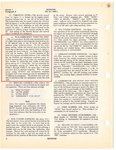GregP
Major
Speaking of high speeds and Oscars in the same sentence isn't something I usually contemplate ...
Follow along with the video below to see how to install our site as a web app on your home screen.
Note: This feature may not be available in some browsers.
Ad: This forum contains affiliate links to products on Amazon and eBay. More information in Terms and rules
Would that roll advantage hold true if the P-39's wing guns (and associated ammunition) were removed?
The more notable examples of problems with the P-39 spinning seem to be shifting loadouts and pilots with experience in one configuration having trouble in another. (mostly with nose-light loadings having problems -I'm not sure if the 20 mm armed versions were any better or worse)
The other problem was that the P-39's flat spin was irrecoverable at any altitude under some conditions. (I believe it was only under nose-light circumstances, but I'm not positive)
If you mean the P-40Q with the mechanical two stage engine, it would have benefited the P-39 also. An E model V-1710 for the P-39 with mechanical second stage was developed in parallel with the F model for the P-40Q. Same engines, only difference was the remote reduction gear for the E model. Then both the P-40 and P-39 would have had high altitude capability by mid '43.I'd cancel the P-39 and go forward with the XP-40Q, hands down.
I think you just speed up the time line by about 6-9 months.
At least one of the P-40-Qs had more than one engine. In fact the first one went through several engines and 2nd may well have flown with Both F27 and F28 engines. Or the first had it's engine rebuilt/modified at least twice and was updated to model specs when rebuilt.
In Mid 1943 the two stage Allison was good for about 1150hp at 20,000ft despite making well over 1800hp at sea level and that is just not enough in planes weighing close to 9000lbs.
The V-1710-93 (Allison model E-11) actually made 1180HP at 21500'. The contemporary V1710-85 powering the P-39N made about 900HP at the same altitude. That extra 280HP represents a 31% increase. A normal P-39N weighed 7650#, add the second stage and a four blade propeller and it's still under 8000#.I think you just speed up the time line by about 6-9 months.
At least one of the P-40-Qs had more than one engine. In fact the first one went through several engines and 2nd may well have flown with Both F27 and F28 engines. Or the first had it's engine rebuilt/modified at least twice and was updated to model specs when rebuilt.
In Mid 1943 the two stage Allison was good for about 1150hp at 20,000ft despite making well over 1800hp at sea level and that is just not enough in planes weighing close to 9000lbs.
They got the two stage Allison into a modified P-39D resulting in the experimental -E. They moved the coolant tank up between the engine and the pilot and put the second stage where the coolant tank had been (same as P-63). The size of the area that held the second stage was exactly the same size on the P-39 an the P-63. Just a little internal rearranging.Agree with that.
Even such V-1710s would've much improve the performance of P39s (in case they can fit at the 1st plac, I won't bet my house on it) and P-40s, even when compared with P-39N and P-40N.
The V-1710-93 (Allison model E-11) actually made 1180HP at 21500'. The contemporary V1710-85 powering the P-39N made about 900HP at the same altitude. That extra 280HP represents a 31% increase. A normal P-39N weighed 7650#, add the second stage and a four blade propeller and it's still under 8000#.
They got the two stage Allison into a modified P-39D resulting in the experimental -E. They moved the coolant tank up between the engine and the pilot and put the second stage where the coolant tank had been (same as P-63). The size of the area that held the second stage was exactly the same size on the P-39 an the P-63. Just a little internal rearranging.
The P-39D-2, K and L used the 1325HP engine (same T/O HP as -93) and cooled adequately.
V-1710 will make military power (1280HP at 21500') for 5 minutes. Without water injection or an intercooler there would be no WEP. P-38F/G didn't have WEP and an early P-63 would do 390mph at 30000' before water injection (no WEP). Still a huge performance increase even without WEP.

The P-39D-2, K and L used the 1325HP engine (same T/O HP as -93) and cooled adequately.